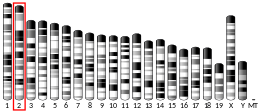SNAI1
아연집게 단백질 SNAI1 (Zinc finger protein SNAI1)은 단백질로 SNAI1유전자에 의해 암호화되어있다.[5][6]
기능
편집초파리 배아 단백질 SNAI1은 아연집게 전사 억제자로 중배엽내의 외배엽유전자의 발현을 하향 조절한다. 이 유전자에 의해 암호화 된 핵단백질은 구조적으로 초파리의 SNAI1 단백질과 유사하다. 그리고 발생하는 배아에 있어 중배엽의 형성에 매우 중요하다 생각된다. 2번 염색체의 최소한 두 가지의 변형된 위유전자가 발견되었다.[6]
임상적 중요성
편집SNAI1 유전자는 E-캐드헤린의 CDH1유전자의 발현을 하향 조절하여 EMT(epithelial-mesenchymal transition)을 유발하여 유방암의 재발하게 함을 보여주었다.[7]
상호작용
편집각주
편집- ↑ 가 나 다 GRCh38: Ensembl release 89: ENSG00000124216 - 앙상블, May 2017
- ↑ 가 나 다 GRCm38: Ensembl release 89: ENSMUSG00000042821 - 앙상블, May 2017
- ↑ “Human PubMed Reference:”. 《National Center for Biotechnology Information, U.S. National Library of Medicine》.
- ↑ “Mouse PubMed Reference:”. 《National Center for Biotechnology Information, U.S. National Library of Medicine》.
- ↑ Paznekas WA; Okajima K; Schertzer M; Wood S; Jabs EW (2000년 2월). “Genomic organization, expression, and chromosome location of the human SNAIL gene (SNAI1) and a related processed pseudogene (SNAI1P)”. 《Genomics》 62 (1): 42–9. doi:10.1006/geno.1999.6010. PMID 10585766.
- ↑ 가 나 “Entrez Gene: SNAI1 snail homolog 1 (Drosophila)”.
- ↑ Davidson NE; Sukumar S (2005년 9월). “Of Snail, mice, and women”. 《Cancer Cell》 8 (3): 173–4. doi:10.1016/j.ccr.2005.08.006. PMID 16169460.
- ↑ 가 나 다 Wu Y; Evers BM; Zhou BP (2009년 1월). “Small C-terminal domain phosphatase enhances snail activity through dephosphorylation”. 《J. Biol. Chem.》 284 (1): 640–8. doi:10.1074/jbc.M806916200. PMC 2610500. PMID 19004823.
참고 자료
편집- Twigg SR; Wilkie AO (1999). “Characterisation of the human snail (SNAI1) gene and exclusion as a major disease gene in craniosynostosis.”. 《Hum. Genet.》 105 (4): 320–6. doi:10.1007/s004390051108. PMID 10543399.
- Batlle E; Sancho E; Francí C; 외. (2000). “The transcription factor snail is a repressor of E-cadherin gene expression in epithelial tumour cells.”. 《Nat. Cell Biol.》 2 (2): 84–9. doi:10.1038/35000034. PMID 10655587.
- Smith S; Metcalfe JA; Elgar G (2000). “Identification and analysis of two snail genes in the pufferfish (Fugu rubripes) and mapping of human SNA to 20q.”. 《Gene》 247 (1–2): 119–28. doi:10.1016/S0378-1119(00)00110-4. PMID 10773451.
- Okubo T; Truong TK; Yu B; 외. (2001). “Down-regulation of promoter 1.3 activity of the human aromatase gene in breast tissue by zinc-finger protein, snail (SnaH)”. 《Cancer Res.》 61 (4): 1338–46. PMID 11245431.
- Deloukas P; Matthews LH; Ashurst J; 외. (2002). “The DNA sequence and comparative analysis of human chromosome 20”. 《Nature》 414 (6866): 865–71. doi:10.1038/414865a. PMID 11780052.
- Blanco MJ; Moreno-Bueno G; Sarrio D; 외. (2002). “Correlation of Snail expression with histological grade and lymph node status in breast carcinomas”. 《Oncogene》 21 (20): 3241–6. doi:10.1038/sj.onc.1205416. PMID 12082640.
- Guaita S; Puig I; Franci C; 외. (2002). “Snail induction of epithelial to mesenchymal transition in tumor cells is accompanied by MUC1 repression and ZEB1 expression”. 《J. Biol. Chem.》 277 (42): 39209–16. doi:10.1074/jbc.M206400200. PMID 12161443.
- Strausberg RL; Feingold EA; Grouse LH; 외. (2003). “Generation and initial analysis of more than 15,000 full-length human and mouse cDNA sequences”. 《Proc. Natl. Acad. Sci. U.S.A.》 99 (26): 16899–903. doi:10.1073/pnas.242603899. PMC 139241. PMID 12477932.
- Yokoyama K; Kamata N; Fujimoto R; 외. (2003). “Increased invasion and matrix metalloproteinase-2 expression by Snail-induced mesenchymal transition in squamous cell carcinomas”. 《Int. J. Oncol.》 22 (4): 891–8. PMID 12632084.
- Ikenouchi J; Matsuda M; Furuse M; Tsukita S (2004). “Regulation of tight junctions during the epithelium-mesenchyme transition: direct repression of the gene expression of claudins/occludin by Snail”. 《J. Cell. Sci.》 116 (Pt 10): 1959–67. doi:10.1242/jcs.00389. PMID 12668723.
- Domínguez D; Montserrat-Sentís B; Virgós-Soler A; 외. (2003). “Phosphorylation regulates the subcellular location and activity of the snail transcriptional repressor”. 《Mol. Cell. Biol.》 23 (14): 5078–89. doi:10.1128/MCB.23.14.5078-5089.2003. PMC 162233. PMID 12832491.
- Imai T; Horiuchi A; Wang C; 외. (2003). “Hypoxia attenuates the expression of E-cadherin via up-regulation of SNAIL in ovarian carcinoma cells”. 《Am. J. Pathol.》 163 (4): 1437–47. doi:10.1016/S0002-9440(10)63501-8. PMC 1868286. PMID 14507651.
- Miyoshi A; Kitajima Y; Sumi K; 외. (2004). “Snail and SIP1 increase cancer invasion by upregulating MMP family in hepatocellular carcinoma cells”. 《Br. J. Cancer》 90 (6): 1265–73. doi:10.1038/sj.bjc.6601685. PMC 2409652. PMID 15026811.
- Ohkubo T; Ozawa M (2004). “The transcription factor Snail downregulates the tight junction components independently of E-cadherin downregulation”. 《J. Cell. Sci.》 117 (Pt 9): 1675–85. doi:10.1242/jcs.01004. PMID 15075229.
- Barberà MJ; Puig I; Domínguez D; 외. (2004). “Regulation of Snail transcription during epithelial to mesenchymal transition of tumor cells”. 《Oncogene》 23 (44): 7345–54. doi:10.1038/sj.onc.1207990. PMID 15286702.
- Beausoleil SA; Jedrychowski M; Schwartz D; 외. (2004). “Large-scale characterization of HeLa cell nuclear phosphoproteins”. 《Proc. Natl. Acad. Sci. U.S.A.》 101 (33): 12130–5. doi:10.1073/pnas.0404720101. PMC 514446. PMID 15302935.
- Kajita M; McClinic KN; Wade PA (2004). “Aberrant expression of the transcription factors snail and slug alters the response to genotoxic stress”. 《Mol. Cell. Biol.》 24 (17): 7559–66. doi:10.1128/MCB.24.17.7559-7566.2004. PMC 506998. PMID 15314165.
- Zhou BP; Deng J; Xia W; 외. (2004). “Dual regulation of Snail by GSK-3beta-mediated phosphorylation in control of epithelial-mesenchymal transition”. 《Nat. Cell Biol.》 6 (10): 931–40. doi:10.1038/ncb1173. PMID 15448698.
- Saito T; Oda Y; Kawaguchi K; 외. (2004). “E-cadherin mutation and Snail overexpression as alternative mechanisms of E-cadherin inactivation in synovial sarcoma”. 《Oncogene》 23 (53): 8629–38. doi:10.1038/sj.onc.1207960. PMID 15467754.





